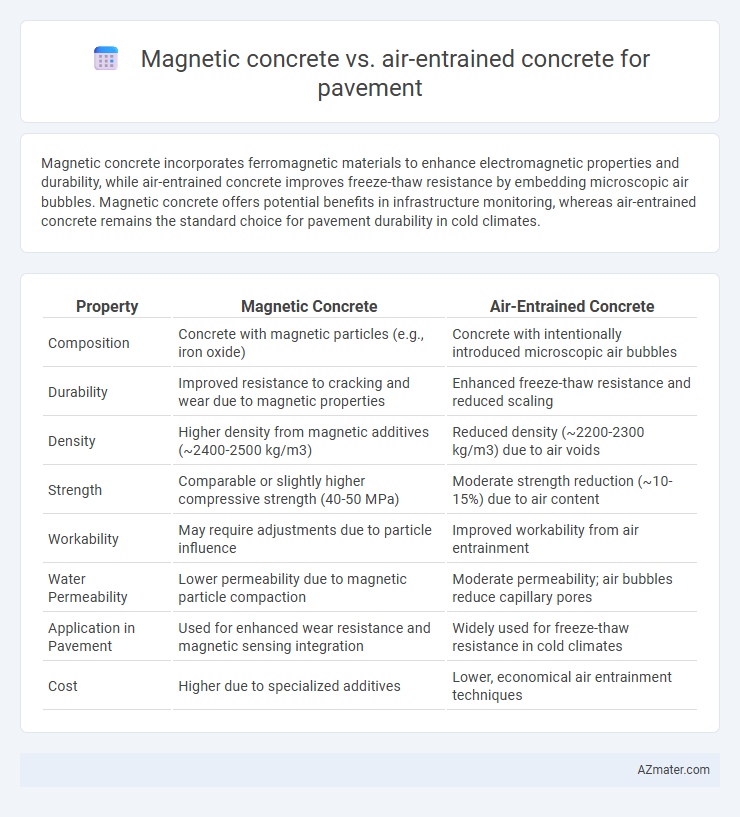Magnetic concrete incorporates ferromagnetic materials to enhance electromagnetic properties and durability, while air-entrained concrete improves freeze-thaw resistance by embedding microscopic air bubbles. Magnetic concrete offers potential benefits in infrastructure monitoring, whereas air-entrained concrete remains the standard choice for pavement durability in cold climates.
Table of Comparison
| Property | Magnetic Concrete | Air-Entrained Concrete |
|---|---|---|
| Composition | Concrete with magnetic particles (e.g., iron oxide) | Concrete with intentionally introduced microscopic air bubbles |
| Durability | Improved resistance to cracking and wear due to magnetic properties | Enhanced freeze-thaw resistance and reduced scaling |
| Density | Higher density from magnetic additives (~2400-2500 kg/m3) | Reduced density (~2200-2300 kg/m3) due to air voids |
| Strength | Comparable or slightly higher compressive strength (40-50 MPa) | Moderate strength reduction (~10-15%) due to air content |
| Workability | May require adjustments due to particle influence | Improved workability from air entrainment |
| Water Permeability | Lower permeability due to magnetic particle compaction | Moderate permeability; air bubbles reduce capillary pores |
| Application in Pavement | Used for enhanced wear resistance and magnetic sensing integration | Widely used for freeze-thaw resistance in cold climates |
| Cost | Higher due to specialized additives | Lower, economical air entrainment techniques |
Introduction to Magnetic Concrete and Air-entrained Concrete
Magnetic concrete incorporates ferromagnetic materials such as iron particles to enhance mechanical properties and enable electromagnetic sensing, offering innovative solutions for smart pavement monitoring. Air-entrained concrete contains microscopic air bubbles created by air-entraining agents, improving freeze-thaw resistance and durability essential for pavement subjected to harsh weather conditions. Both materials address pavement longevity, with magnetic concrete enabling advanced structural health monitoring, while air-entrained concrete optimizes durability in freeze-thaw environments.
Composition and Manufacturing Processes
Magnetic concrete incorporates ferromagnetic materials such as magnetite or iron powder, enhancing electromagnetic properties, whereas air-entrained concrete contains microscopic air bubbles introduced through air-entraining agents to improve freeze-thaw resistance. The manufacturing process of magnetic concrete requires precise mixing of magnetic additives to ensure uniform magnetic particle distribution, while air-entrained concrete involves controlled dosing and agitation to trap stable air voids within the cement matrix. Both types utilize standard concrete batching equipment but differ significantly in admixture application and quality control measures to optimize pavement durability and performance.
Key Properties and Performance Attributes
Magnetic concrete incorporates ferromagnetic materials enhancing durability and crack resistance, while air-entrained concrete contains microscopic air bubbles improving freeze-thaw resistance and workability. The key properties of magnetic concrete include higher strength and better electromagnetic interference shielding, making it suitable for smart pavement applications. In contrast, air-entrained concrete excels in durability under cyclic freezing and thawing conditions, offering superior longevity for traditional road surfaces.
Durability Under Harsh Environmental Conditions
Magnetic concrete incorporates ferromagnetic materials enhancing durability by improving crack resistance and reducing surface wear, making it effective under harsh environmental conditions such as freeze-thaw cycles and heavy traffic loads. Air-entrained concrete contains microscopic air bubbles that improve freeze-thaw resistance and reduce water permeability, significantly enhancing durability in cold climates prone to deicing salts. While magnetic concrete offers improved mechanical resilience, air-entrained concrete remains the industry standard for long-term durability in pavements exposed to severe weather stressors.
Freeze-Thaw Resistance Comparison
Magnetic concrete incorporates ferromagnetic materials that improve the internal microstructure, enhancing freeze-thaw resistance compared to traditional air-entrained concrete by reducing microcracking and scaling. Air-entrained concrete improves freeze-thaw durability through controlled air voids that accommodate ice expansion, but magnetic concrete demonstrates superior long-term performance by maintaining higher compressive strength and durability under cyclic freeze-thaw conditions. Studies show magnetic concrete's unique composition offers more effective mitigation of freeze-thaw damage, making it a promising alternative for pavements exposed to severe cold climates.
Structural Strength and Load-Bearing Capacity
Magnetic concrete exhibits enhanced structural strength due to the incorporation of magnetic nanoparticles, which improve the matrix bonding and durability under stress. Air-entrained concrete, designed with microscopic air bubbles, primarily enhances freeze-thaw resistance but generally has lower load-bearing capacity compared to magnetic concrete. For pavement applications requiring superior strength and high load-bearing capacity, magnetic concrete offers a more robust solution than air-entrained concrete.
Impact on Pavement Longevity and Maintenance
Magnetic concrete enhances pavement longevity by improving crack resistance and reducing freeze-thaw damage through enhanced internal microstructure stability. Air-entrained concrete extends pavement life by incorporating microscopic air bubbles that mitigate freeze-thaw cycles and reduce surface scaling, lowering maintenance costs. Comparative studies show magnetic concrete offers superior durability in high-stress environments, while air-entrained concrete excels in cold climates prone to frequent freeze-thaw conditions.
Sustainability and Environmental Considerations
Magnetic concrete integrates ferromagnetic materials that enhance durability and reduce urban heat island effects, promoting energy efficiency in pavement applications. Air-entrained concrete improves freeze-thaw resistance by incorporating microscopic air bubbles, extending pavement lifespan and reducing maintenance frequency. Both materials contribute to sustainability by lowering resource consumption and minimizing environmental impact through enhanced durability and performance.
Cost-effectiveness and Economic Analysis
Magnetic concrete incorporates ferromagnetic materials that enhance durability and reduce maintenance costs, offering long-term economic benefits despite higher initial expenses compared to traditional air-entrained concrete. Air-entrained concrete, commonly used for pavements, improves freeze-thaw resistance and reduces cracking, resulting in lower upfront costs and reliable performance in cold climates. Economic analysis reveals magnetic concrete's potential for lifecycle cost savings in heavy-traffic or harsh environments, while air-entrained concrete remains more cost-effective for standard pavement applications with moderate load and weather conditions.
Suitability for Pavement Applications and Final Recommendations
Magnetic concrete offers enhanced durability and self-healing properties suitable for high-traffic pavement applications, improving longevity and reducing maintenance costs. Air-entrained concrete provides superior freeze-thaw resistance and improved workability, making it ideal for pavements exposed to harsh weather conditions. Final recommendations favor magnetic concrete for urban and industrial pavements requiring strength and durability, while air-entrained concrete is preferred in cold climates with frequent freeze-thaw cycles to prevent surface deterioration.

Infographic: Magnetic concrete vs Air-entrained concrete for Pavement
 azmater.com
azmater.com